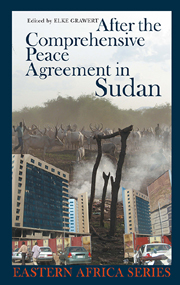Book contents
- Frontmatter
- Contents
- List of Tables & Figures
- Editor's Preface
- Notes on Contributors
- List of Acronyms
- Map of Sudan
- 1 Introduction
- I Implementation & Potential of the CPA
- 2 The Role of African & Arab Elites in Building a New Sudan
- 3 After the CPA
- 4 Empowered Deliberative Democracy (EDD)
- II Challenges Facing Post-war Societies in Sudan
- III The CPA in its Sub-regional Context
- IV Beyond the CPA
- Index
- EASTERN AFRICAN STUDIES
2 - The Role of African & Arab Elites in Building a New Sudan
from I - Implementation & Potential of the CPA
Published online by Cambridge University Press: 05 April 2013
- Frontmatter
- Contents
- List of Tables & Figures
- Editor's Preface
- Notes on Contributors
- List of Acronyms
- Map of Sudan
- 1 Introduction
- I Implementation & Potential of the CPA
- 2 The Role of African & Arab Elites in Building a New Sudan
- 3 After the CPA
- 4 Empowered Deliberative Democracy (EDD)
- II Challenges Facing Post-war Societies in Sudan
- III The CPA in its Sub-regional Context
- IV Beyond the CPA
- Index
- EASTERN AFRICAN STUDIES
Summary
Introduction
For more than fifty years, Sudan has been at war with itself. National and international interventions with the aim of putting an end to the country's crisis have failed. It is worthwhile, therefore, to ask what the conflict in Sudan is all about: who is fighting whom, whether it is a racial conflict between the Africans and Arabs of Sudan, or whether it is a conflict between Arab and African elites, and who are these elites? This chapter tries to give brief answers to these questions.
The Balad el-Sudan, or the Land of Blacks, gained its independence from the Anglo-Egyptian condominium in 1956. Inhabited by about 40 million people, it comprises more than 500 different tribes, each with its own culture, language, or dialect. Politically, the country is divided into two main groups – Arabs and Africans or non-Arabs, who make up about 80 per cent of the population. From a religious perspective, Sudan is a country of Muslims, Christians and believers of African religions, and was considered by some scholars to have been relatively peaceful up to 1955. The diversities, ethnic, religious, cultural and regional divides which are seen today, did in fact exist during colonial rule, but the country was peaceful and stable. It was shortly before independence that the crisis began.
This situation has led many political and social scientists to study the root causes of the Sudan crisis (Diraige 1995: 113–4). Some of them define the Sudan conflict as a political conflict between the Arabs and Africans of Sudan (Beshir 1968: vii) or as a ‘war of visions’ (Deng 1995: vii) between these two groups.
- Type
- Chapter
- Information
- After the Comprehensive Peace Agreement in Sudan , pp. 29 - 50Publisher: Boydell & BrewerPrint publication year: 2010



